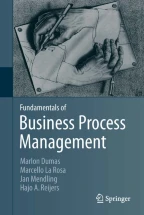Introduction to Business Process Management

Business Process Management (BPM) is the art and science of overseeing how work is performed in an organization to ensure consistent outcomes and to take advantage of improvement opportunities. In this context, the term “improvement” may take different meanings depending on the objectives of the organization. Typical examples of improvement objectives include reducing costs, reducing execution times and reducing error rates. Improvement initiatives may be one-off, but also display a more continuous nature. Importantly, BPM is not about improving the way individual activities are performed. Rather, it is about managing entire chains of events, activities and decisions that ultimately add value to the organization and its customers. These “chains of events, activities and decisions” are called processes.
In this chapter, we introduce a few essential concepts behind BPM. We will start with a description of typical processes that are found in contemporary organizations. Next, we discuss the basic ingredients of a business process and we provide a definition of business process and BPM. In order to place BPM in a broader perspective, we then provide a historical overview of the BPM discipline. Finally, we discuss how a BPM initiative in an organization typically unfolds. This discussion leads us to the definition of a BPM lifecycle around which the book is structured.
Ab ovo usque ad mala.
Horace (65 BCE–8 BCE)
This is a preview of subscription content, log in via an institution to check access.
Access this chapter
Notes
In reality, ERP systems are much more than a shared database. They also incorporate numerous modules to support typical functions of an organization such as accounting, inventory management, production planning, logistics, etc. However, from the perspective of process improvement, the shared database concept behind ERP systems is a major enabler.
This phase is also called process design in the literature. However, process discovery is arguably a more appropriate term since the process already exists, at least implicitly in the heads of the actors who perform it. The goal of this phase is generally to discover the process rather than to design it. In rare cases (e.g. new companies) no process is yet in place so the discovery and analysis phases are not required and the process has to be designed for the first time rather than redesigned.
The role of the customer is not listed in the box as this role is already discussed in previous sections.
References
- J. Becker, M. Kugeler, M. Rosemann, Process Management: a Guide for the Design of Business Processes (Springer, Berlin, 2011) Google Scholar
- S. Conger, Six sigma and business process management, in Handbook of Business Process Management, vol. 1, ed. by J. vom Brocke, M. Rosemann (Springer, Berlin, 2010), pp. 127–148 ChapterGoogle Scholar
- T.H. Davenport, J.E. Short, The new industrial engineering: information technology and business process redesign. Sloan Manag. Rev. 31(4), 11–27 (1990) Google Scholar
- D.J. Elzinga, T. Horak, C.Y. Lee, C. Bruner, Business process management: survey and methodology. IEEE Trans. Eng. Manag. 42(2), 119–128 (1995) ArticleGoogle Scholar
- M. Hammer, Reengineering work: don’t automate, obliterate. Harv. Bus. Rev. 68(4), 104–112 (1990) Google Scholar
- P. Harmon, Business Process Change: A Guide for Business Managers and BPM and Six Sigma Professionals, 2nd edn. (Morgan Kaufmann, San Mateo, 2007) Google Scholar
- M. Laguna, J. Marklund, Business Process Modeling, Simulation and Design (Prentice Hall, New York, 2004) Google Scholar
- K. McCormack, The development of a measure of business process orientation and its relationship to organizational performance, April 1999. Online tutorial available at http://www.prosci.com/mccormack.htm
- G.A. Rummler, A.P. Brache, Improving Performance: Managing the White Space on the Organizational Chart (Jossey-Bass, San Francisco, 1990) Google Scholar
- G.A. Rummler, A.J. Ramias, A framework for defining and designing the structure of work, in Handbook of Business Process Management, vol. 1, ed. by M. Rosemann, J. vom Brocke (Springer, Berlin, 2010) Google Scholar
- J. vom Brocke, M. Rosemann, Handbook on Business Process Management 1: Introduction, Methods, and Information Systems, vol. 1 (Springer, Berlin, 2010) Google Scholar
- J. vom Brocke, M. Rosemann, Handbook on Business Process Management 2: Strategic Alignment, Governance, People and Culture, vol. 2 (Springer, Berlin, 2010) BookGoogle Scholar
Author information
Authors and Affiliations
- Institute of Computer Science, University of Tartu, Tartu, Estonia Marlon Dumas
- Queensland University of Technology and NICTA, Brisbane, Australia Marcello La Rosa
- Institute for Information Business, Vienna University of Economics and Business, Vienna, Austria Jan Mendling
- Department of Mathematics and Computer Science, Eindhoven University of Technology, Eindhoven, The Netherlands Hajo A. Reijers
- Marlon Dumas

